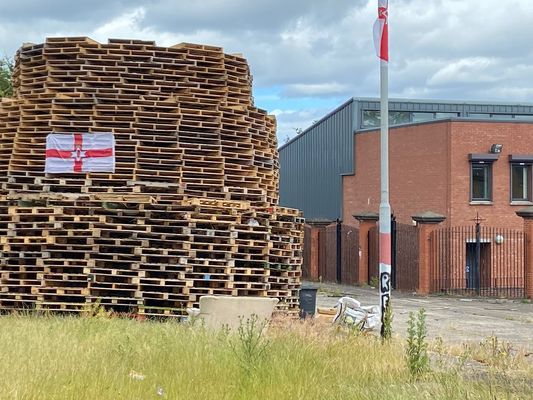ANOTHER summer, another series of rows and confrontations over bonfires. It’s depressing enough that we find ourselves in exactly the same position at exactly the same time every year, but worse, it’s desperately disappointing that in the 12 months since the last round of acrimony absolutely nothing has been done by the bonfire builders or their supporters and enablers within political unionism to address the issues that inevitably arise.
Last year the most bitter dispute sprang up around the Adam Street bonfire at the interface between Tigers Bay and the New Lodge – and this year once again it is that blatantly and cynically inflammatory pyre which is in the news again, this time over the issue of toxic materials. Tyres and plastic material, which of course give off dangerous and even carcinogenic fumes, appearered at the bonfire over the weekend, and after complaints were removed. Those responsible for the bonfire claimed the material in question had been dumped there, but of course dumping spots are exactly what these bonfires are, with the public and businesses alike being encouraged to leave flammable items. So quite why there are complaints by the bonfire organisers about dumping at the bonfire is not entirely clear.
Those responsible for the bonfire this week claimed that nationalist politicians were “gearing up to ignite tensions at our peaceful community celebration”. That is a twisting of the truth that would make Boris Johnson blush, as a quick refresher on the Adam Street bonfire reveals. The fire was deliberately moved as close as possible to the Duncairn Gardens peaceline precisely to ignite the kind of tensions that organisers accuse others of trying to incite. Golf balls were driven from the top of the bonfire across the road into the New Lodge – an outrageous act of blatant intimidation and one which was denied by the builders even though it was caught on video. And in the High Court two months later Mr Justice Horner said the driving of golf balls, the throwing of bricks and nightly sectarian singing around the bonfire had been “intimidation of the worst kind”. He continued: “It was anti-social. This was criminal conduct. It was designed to incite, to try and produce a visceral reaction. It had nothing to do with the celebration of Orange culture and should have had nothing to do with it.”
Such robust and unambiguous language by a High Court judge would in any normal society have ensured that a repeat was not possible. Yet here we are again, facing precisely the same problems that dogged the city last year and which did such considerable damage to community relations.
There is no point in asking those unionist politicians who queued up to have their pictures taken at a bonfire which was, according to Mr Justice Horner, used to “terrorise” residents across the road. We can only hope that the statutory authorities and local community workers do their best to calm things down. A fragile hope, but the only one we have.







